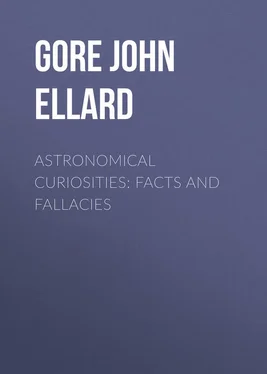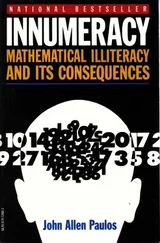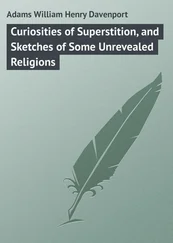John Gore - Astronomical Curiosities - Facts and Fallacies
Здесь есть возможность читать онлайн «John Gore - Astronomical Curiosities - Facts and Fallacies» — ознакомительный отрывок электронной книги совершенно бесплатно, а после прочтения отрывка купить полную версию. В некоторых случаях можно слушать аудио, скачать через торрент в формате fb2 и присутствует краткое содержание. Жанр: Физика, foreign_antique, foreign_prose, на английском языке. Описание произведения, (предисловие) а так же отзывы посетителей доступны на портале библиотеки ЛибКат.
- Название:Astronomical Curiosities: Facts and Fallacies
- Автор:
- Жанр:
- Год:неизвестен
- ISBN:нет данных
- Рейтинг книги:5 / 5. Голосов: 1
-
Избранное:Добавить в избранное
- Отзывы:
-
Ваша оценка:
- 100
- 1
- 2
- 3
- 4
- 5
Astronomical Curiosities: Facts and Fallacies: краткое содержание, описание и аннотация
Предлагаем к чтению аннотацию, описание, краткое содержание или предисловие (зависит от того, что написал сам автор книги «Astronomical Curiosities: Facts and Fallacies»). Если вы не нашли необходимую информацию о книге — напишите в комментариях, мы постараемся отыскать её.
Astronomical Curiosities: Facts and Fallacies — читать онлайн ознакомительный отрывок
Ниже представлен текст книги, разбитый по страницам. Система сохранения места последней прочитанной страницы, позволяет с удобством читать онлайн бесплатно книгу «Astronomical Curiosities: Facts and Fallacies», без необходимости каждый раз заново искать на чём Вы остановились. Поставьте закладку, и сможете в любой момент перейти на страницу, на которой закончили чтение.
Интервал:
Закладка:
The “secondary light” was also seen by Pastorff in 1822, and by Gruithuisen in 1825. Since 1824 observations of the “light” were made by Berry, Browning, Guthrie, Langdon, Noble, Prince, Webb, and others. Webb saw it with powers of 90 and 212 on a 9·38-inch mirror, and found it “equally visible when the bright crescent was hidden by a field bar.” 42 42 Celestial Objects , vol. i. p. 65 (5th Edition).
Captain Noble’s observation was rather unique. He found that the dark side was “always distinctly and positively darker than the background upon which it is projected.”
The “light” was also seen by Lyman in America in 1867, and by Safarik at Prague. In 1871 the whole disc of Venus was seen by Professor Winnecke. 43 43 Ast. Nach. No. 1863.
On the other hand, Winnecke stated that he only saw it twice in 24 years; and the great observers Dawes and Mädler never saw it at all! 44 44 Nature , June 1, 1876.
Various attempts have been made to explain the visibility – at times – of the “dark side” of Venus. The following may be mentioned 45 45 Ibid. , June 8, 1876.
: – (1) Reflected earth-light, analogous to the dark side of the crescent moon. This explanation was advocated by Harding, Schröter, and others. But, although the earth is undoubtedly a bright object in the sky of Venus, the explanation is evidently quite inadequate. (2) Phosphorescence of the planet’s atmosphere. This has been suggested by some observers. (3) Visibility by contrast, a theory advanced by the great French astronomer Arago. (4) Illumination of the planet’s surface by an aurora borealis. This also seems rather inadequate, but would account for the light being sometimes visible and sometimes not. (5) Luminosity of the oceans – if there be any – on Venus. But this also seems inadequate. (6) A planetary surface glowing with intense heat. But this seems improbable. (7) The Kunstliche Feuer (artificial fire) of Gruithuisen, a very fanciful theory. Flammarion thinks that the visibility of the dark side may perhaps be explained by its projection on a somewhat lighter background, such as the zodiacal light, or an extended solar envelope. 46 46 Nature , October 17, 1895.
It will be seen that none of these explanations are entirely satisfactory, and the phenomenon, if real, remains a sort of astronomical enigma. The fact that the “light” is visible on some occasions and not on others would render some of the explanations improbable or even inadmissible. But the condition of the earth’s atmosphere at times might account for its invisibility on many occasions.
A curious suggestion was made by Zöllner, namely, that if the secondary light of Venus could be observed with the spectroscope it would show bright lines! But such an observation would be one of extreme difficulty.
M. Hansky finds that the visibility of the “light” is greater during periods of maximum solar activity – that is, at the maxima of sun spots. This he explains by the theory of Arrhenius, in which electrified “ions emitted by the sun cause the phenomena of terrestrial magnetic storms and auroras.” “In the same way the dense atmosphere of Venus is rendered more phosphorescent, and therefore more easily visible by the increased solar activity.” 47 47 Ibid. , July 27, 1905.
This seems a very plausible hypothesis.
On the whole the occasional illumination of the night side of Venus by a very brilliant aurora (explanation (4) above) seems to the present writer to be the most probable explanation. Gruithuisen’s hypothesis (7) seems utterly improbable.
There is a curious apparent anomaly about the motion of Venus in the sky. Although the planet’s period of revolution round the sun is 224·7 days, it remains on the same side of the sun, as seen from the earth, for 290 days. The reason of this is that the earth is going at the same time round the sun in the same direction, though at a slower pace; and Venus must continue to appear on the same side of the sun until the excess of her daily motion above that of the earth amounts to 179°, and this at the daily rate of 37′ will be about 290 days.
Several observations have been recorded of a supposed satellite of Venus. But the existence of such a body has never been verified. In the year 1887, M. Stroobant investigated the various accounts, and came to the conclusion that in several at least of the recorded observations the object seen was certainly a star. Thus, in the observation made by Rœdickœr and Boserup on August 4, 1761, a satellite and star are recorded as having been seen near the planet. M. Stroobant finds that the supposed “satellite” was the star χ4 Orionis, and the “star” χ3 Orionis. A supposed observation of a satellite made by Horrebow on January 3, 1768, was undoubtedly θ Libræ. M. Stroobant found that the supposed motion of the “satellite” as seen by Horrebow is accurately represented by the motion of Venus itself during the time of observation. In most of the other supposed observations of a satellite a satisfactory identification has also been found. M. Stroobant finds that with a telescope of 6 inches aperture, a star of the 8th or even the 9th magnitude can be well seen when close to Venus. 48 48 Nature , October 6, 1887.
On the night of August 13, 1892, Professor Barnard, while examining Venus with the great 36-inch telescope of the Lick Observatory, saw a star of the 7th magnitude in the same field with the planet. He carefully determined the exact position of this star, and found that it is not in Argelander’s great catalogue, the Durchmusterung . Prof. Barnard finds that owing to elongation of Venus from the sun at the time of observation the star could not possibly be an intra-Mercurial planet (that is, a planet revolving round the sun inside the orbit of Mercury); but that possibly it might be a planet revolving between the orbits of Venus and Mercury. As the brightest of the minor planets – Ceres, Pallas, Juno, and Vesta – were not at the time near the position of the observed object, the observation remains unexplained. It might possibly have been a nova , or temporary star. 49 49 Ast. Nach. , No. 4106.
Scheuten is said to have seen a supposed satellite of Venus following the planet across the sun at the end of the transit of June 6, 1761. 50 50 Copernicus , vol. ii. p. 168.
Humboldt speaks of the supposed satellite of Venus as among “the astronomical myths of an uncritical age.” 51 51 Cosmos , vol. iv. p. 476, footnote.
An occultation of Venus by the moon is mentioned in the Chinese Annals as having occurred on March 19, 361 A.D., and Tycho Brahé observed another on May 23, 1587. 52 52 Denning, Telescopic Work for Starlight Evenings , p. 153.
A close conjunction of Venus and Regulus (α Leonis) is recorded by the Arabian astronomer, Ibn Yunis, as having occurred on September 9, 885 A.D. Calculations by Hind show that the planet and star were within 2′ of arc on that night, and consequently would have appeared as a single star to the naked eye. The telescope had not then been invented. 53 53 Ibid. , p. 154.
Seen from Venus, the maximum apparent distance between the earth and moon would vary from about 5′ to 31′. 54 54 Nature , July 13, 1876.
It is related by Arago that Buonaparte, when going to the Luxembourg in Paris, where the Directory were giving a fête in his honour, was very much surprised to find the crowd assembled in the Rue de Touracour “pay more attention to a region of the heavens situated above the palace than to his person or the brilliant staff that accompanied him. He inquired the cause and learned that these curious persons were observing with astonishment, although it was noon, a star, which they supposed to be that of the conqueror of Italy – an allusion to which the illustrious general did not seem indifferent, when he himself, with his piercing eyes, remarked the radiant body.” The “star” in question was Venus. 55 55 P. M. Ryves in Knowledge , June 1, 1897, p. 144.
Интервал:
Закладка:
Похожие книги на «Astronomical Curiosities: Facts and Fallacies»
Представляем Вашему вниманию похожие книги на «Astronomical Curiosities: Facts and Fallacies» списком для выбора. Мы отобрали схожую по названию и смыслу литературу в надежде предоставить читателям больше вариантов отыскать новые, интересные, ещё непрочитанные произведения.
Обсуждение, отзывы о книге «Astronomical Curiosities: Facts and Fallacies» и просто собственные мнения читателей. Оставьте ваши комментарии, напишите, что Вы думаете о произведении, его смысле или главных героях. Укажите что конкретно понравилось, а что нет, и почему Вы так считаете.











